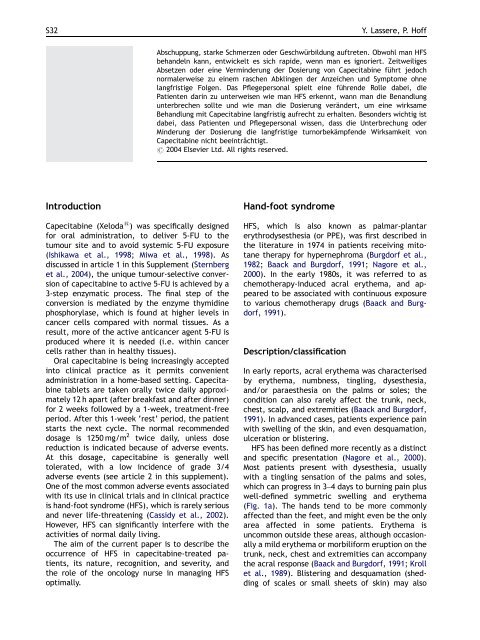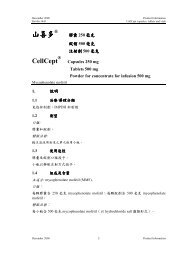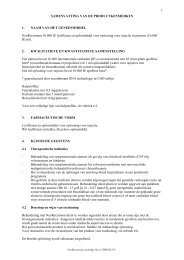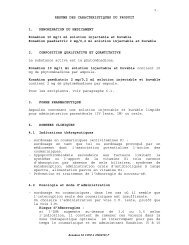Management of hand-foot syndrome in patients treated with ...
Management of hand-foot syndrome in patients treated with ...
Management of hand-foot syndrome in patients treated with ...
Create successful ePaper yourself
Turn your PDF publications into a flip-book with our unique Google optimized e-Paper software.
S32<br />
Introduction<br />
Capecitab<strong>in</strong>e (Xeloda s ) was specifically designed<br />
for oral adm<strong>in</strong>istration, to deliver 5-FU to the<br />
tumour site and to avoid systemic 5-FU exposure<br />
(Ishikawa et al., 1998; Miwa et al., 1998). As<br />
discussed <strong>in</strong> article 1 <strong>in</strong> this Supplement (Sternberg<br />
et al., 2004), the unique tumour-selective conversion<br />
<strong>of</strong> capecitab<strong>in</strong>e to active 5-FU is achieved by a<br />
3-step enzymatic process. The f<strong>in</strong>al step <strong>of</strong> the<br />
conversion is mediated by the enzyme thymid<strong>in</strong>e<br />
phosphorylase, which is found at higher levels <strong>in</strong><br />
cancer cells compared <strong>with</strong> normal tissues. As a<br />
result, more <strong>of</strong> the active anticancer agent 5-FU is<br />
produced where it is needed (i.e. <strong>with</strong><strong>in</strong> cancer<br />
cells rather than <strong>in</strong> healthy tissues).<br />
Oral capecitab<strong>in</strong>e is be<strong>in</strong>g <strong>in</strong>creas<strong>in</strong>gly accepted<br />
<strong>in</strong>to cl<strong>in</strong>ical practice as it permits convenient<br />
adm<strong>in</strong>istration <strong>in</strong> a home-based sett<strong>in</strong>g. Capecitab<strong>in</strong>e<br />
tablets are taken orally twice daily approximately<br />
12 h apart (after breakfast and after d<strong>in</strong>ner)<br />
for 2 weeks followed by a 1-week, treatment-free<br />
period. After this 1-week ‘rest’ period, the patient<br />
starts the next cycle. The normal recommended<br />
dosage is 1250 mg/m 2 twice daily, unless dose<br />
reduction is <strong>in</strong>dicated because <strong>of</strong> adverse events.<br />
At this dosage, capecitab<strong>in</strong>e is generally well<br />
tolerated, <strong>with</strong> a low <strong>in</strong>cidence <strong>of</strong> grade 3/4<br />
adverse events (see article 2 <strong>in</strong> this supplement).<br />
One <strong>of</strong> the most common adverse events associated<br />
<strong>with</strong> its use <strong>in</strong> cl<strong>in</strong>ical trials and <strong>in</strong> cl<strong>in</strong>ical practice<br />
is <strong>hand</strong>-<strong>foot</strong> <strong>syndrome</strong> (HFS), which is rarely serious<br />
and never life-threaten<strong>in</strong>g (Cassidy et al., 2002).<br />
However, HFS can significantly <strong>in</strong>terfere <strong>with</strong> the<br />
activities <strong>of</strong> normal daily liv<strong>in</strong>g.<br />
The aim <strong>of</strong> the current paper is to describe the<br />
occurrence <strong>of</strong> HFS <strong>in</strong> capecitab<strong>in</strong>e-<strong>treated</strong> <strong>patients</strong>,<br />
its nature, recognition, and severity, and<br />
the role <strong>of</strong> the oncology nurse <strong>in</strong> manag<strong>in</strong>g HFS<br />
optimally.<br />
ARTICLE IN PRESS<br />
Abschuppung, starke Schmerzen oder Geschwürbildung auftreten. Obwohl man HFS<br />
be<strong>hand</strong>eln kann, entwickelt es sich rapide, wenn man es ignoriert. Zeitweiliges<br />
Absetzen oder e<strong>in</strong>e Verm<strong>in</strong>derung der Dosierung von Capecitab<strong>in</strong>e führt jedoch<br />
normalerweise zu e<strong>in</strong>em raschen Abkl<strong>in</strong>gen der Anzeichen und Symptome ohne<br />
langfristige Folgen. Das Pflegepersonal spielt e<strong>in</strong>e führende Rolle dabei, die<br />
Patienten dar<strong>in</strong> zu unterweisen wie man HFS erkennt, wann man die Benandlung<br />
unterbrechen sollte und wie man die Dosierung verändert, um e<strong>in</strong>e wirksame<br />
Be<strong>hand</strong>lung mit Capecitab<strong>in</strong>e langfristig aufrecht zu erhalten. Besonders wichtig ist<br />
dabei, dass Patienten und Pflegepersonal wissen, dass die Unterbrechung oder<br />
M<strong>in</strong>derung der Dosierung die langfristige turnorbekämpfende Wirksamkeit von<br />
Capecitab<strong>in</strong>e nicht bee<strong>in</strong>trǎchtigt.<br />
r 2004 Elsevier Ltd. All rights reserved.<br />
Hand-<strong>foot</strong> <strong>syndrome</strong><br />
HFS, which is also known as palmar-plantar<br />
erythrodysesthesia (or PPE), was first described <strong>in</strong><br />
the literature <strong>in</strong> 1974 <strong>in</strong> <strong>patients</strong> receiv<strong>in</strong>g mitotane<br />
therapy for hypernephroma (Burgdorf et al.,<br />
1982; Baack and Burgdorf, 1991; Nagore et al.,<br />
2000). In the early 1980s, it was referred to as<br />
chemotherapy-<strong>in</strong>duced acral erythema, and appeared<br />
to be associated <strong>with</strong> cont<strong>in</strong>uous exposure<br />
to various chemotherapy drugs (Baack and Burgdorf,<br />
1991).<br />
Description/classification<br />
Y. Lassere, P. H<strong>of</strong>f<br />
In early reports, acral erythema was characterised<br />
by erythema, numbness, t<strong>in</strong>gl<strong>in</strong>g, dysesthesia,<br />
and/or paraesthesia on the palms or soles; the<br />
condition can also rarely affect the trunk, neck,<br />
chest, scalp, and extremities (Baack and Burgdorf,<br />
1991). In advanced cases, <strong>patients</strong> experience pa<strong>in</strong><br />
<strong>with</strong> swell<strong>in</strong>g <strong>of</strong> the sk<strong>in</strong>, and even desquamation,<br />
ulceration or blister<strong>in</strong>g.<br />
HFS has been def<strong>in</strong>ed more recently as a dist<strong>in</strong>ct<br />
and specific presentation (Nagore et al., 2000).<br />
Most <strong>patients</strong> present <strong>with</strong> dysesthesia, usually<br />
<strong>with</strong> a t<strong>in</strong>gl<strong>in</strong>g sensation <strong>of</strong> the palms and soles,<br />
which can progress <strong>in</strong> 3–4 days to burn<strong>in</strong>g pa<strong>in</strong> plus<br />
well-def<strong>in</strong>ed symmetric swell<strong>in</strong>g and erythema<br />
(Fig. 1a). The <strong>hand</strong>s tend to be more commonly<br />
affected than the feet, and might even be the only<br />
area affected <strong>in</strong> some <strong>patients</strong>. Erythema is<br />
uncommon outside these areas, although occasionally<br />
a mild erythema or morbiliform eruption on the<br />
trunk, neck, chest and extremities can accompany<br />
the acral response (Baack and Burgdorf, 1991; Kroll<br />
et al., 1989). Blister<strong>in</strong>g and desquamation (shedd<strong>in</strong>g<br />
<strong>of</strong> scales or small sheets <strong>of</strong> sk<strong>in</strong>) may also










